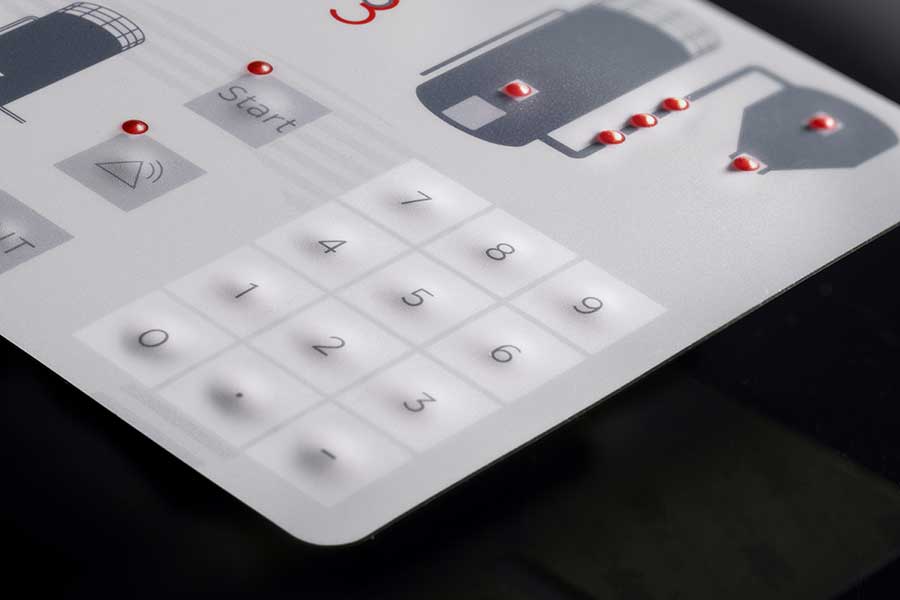The Function of Membrane Layer Changes in Enhancing Device Usability and Appearance
Membrane layer switches stand for a substantial innovation in user interface modern technology, seamlessly integrating functionality with aesthetic appeal. Their style is not only practical, providing receptive controls in a compact type, but also personalized, enabling for special branding and visual involvement. As industries progressively focus on individual experience, the ramifications of these functions prolong beyond simple comfort, affecting product layout and consumer satisfaction. What stays to be checked out is exactly how these elements will advance in feedback to emerging fads and technological developments, forming the future of human-device interaction.
Recognizing Membrane Layer Switch Over Innovation

The visuals overlay acts as the visible surface area, typically printed with symbols and tags that direct individual communication. Beneath this layer, the spacer works as a separator, guaranteeing that the conductive layer only makes get in touch with when a button is pressed. The conductive layer, generally made from a conductive ink or product, completes the circuit and sends out signals to the gadget's electronics.
Resilience is a significant benefit of membrane layer buttons, as they are resistant to wetness, dirt, and impurities, making them suitable for different atmospheres. Furthermore, membrane switches can be personalized in regards to form, dimension, and design, permitting manufacturers to tailor interfaces to certain gadget needs. This convenience adds to their extensive use throughout markets, from customer electronic devices to clinical gadgets.
Usability Advantages of Membrane Layer Switches
The functionality benefits of membrane layer buttons appear in their instinctive style and user-friendly features. These switches assist in straightforward interaction by incorporating tactile responses and well-known icons, which improve the customer experience through clear interaction of feature (Membrane Switch). The level profile of membrane layer switches permits very easy combination into numerous gadgets, reducing the learning contour for individuals unfamiliar with complicated controls
Additionally, membrane switches are commonly created with level of sensitivity in mind, enabling customers to involve with controls effortlessly. This particular is particularly helpful in environments where quick reactions are crucial, such as medical devices and industrial machinery. Their resistance to wetness and contaminants better makes certain reliable procedure, promoting customer self-confidence in diverse setups.
Moreover, membrane layer buttons can be personalized to match specific applications, accommodating unique individual demands and choices. This versatility cultivates a sense of ownership among users, as they can communicate with controls that feel customized to their needs.
Aesthetic Enhancements With Layout
Aesthetic improvements play a considerable function in the overall allure and functionality of devices outfitted with membrane buttons. These switches supply versatile style opportunities that can be tailored to meet brand identity and customer preferences. The capacity to include vibrant colors, personalized graphics, and varied structures allows manufacturers to produce aesthetically striking user interfaces that resonate with customers on an emotional level.
The flexibility of membrane switch style additionally promotes the assimilation of one-of-a-kind shapes and layouts, adding to a structured appearance that enhances the individual experience. This not just makes gadgets a lot more eye-catching however also aids in instinctive navigating, as individuals can quickly determine practical areas and controls. Furthermore, progressed printing innovations enable the reproduction of intricate designs and high-resolution pictures, additionally boosting the aesthetic quality.
In addition, using backlighting in membrane layer buttons can substantially improve exposure and charm, specifically in low-light environments. This mix of appearances and capability cultivates an engaging customer experience, making devices not just much more pleasurable to utilize however likewise much more aligned with modern layout fads. Inevitably, visual enhancements with careful membrane button layout can change common tools right into engaging, easy to use products.
Applications in Various Industries
In various sectors, membrane layer buttons have ended up being indispensable parts that improve capability and functionality across a large range of tools. These cutting-edge switches find applications in industries such as health care, consumer electronic devices, automotive, and industrial equipment.
In the healthcare industry, membrane layer buttons are generally used in clinical devices, such as analysis equipment and person monitoring systems, where they give intuitive user interfaces that boost individual interaction while preserving health. Similarly, in customer electronic devices, membrane switches assist in straightforward controls in devices, remote controls, and video gaming devices, using smooth procedure and aesthetic allure.

Future Trends in Membrane Layer Switches
Arising patterns in membrane switches are readied to transform interface throughout various applications, driven by advancements in modern technology and increasing consumer needs for capability and design. One significant pattern is the unification of capacitive touch technology, which provides an extra responsive and modern individual experience compared to typical mechanical buttons (Membrane Switch). This shift not just enhances use yet also permits Discover More sleeker tool visual appeals
In addition, the assimilation of customizable graphics and backlighting is coming to be increasingly popular. Manufacturers are leveraging innovative imp source printing techniques and LED modern technology to produce aesthetically appealing user interfaces that satisfy specific customer requires while improving device visibility in numerous lights problems. This customization fosters a stronger psychological link between individuals and their gadgets.

Final Thought
To conclude, membrane layer changes dramatically enhance both functionality and looks in modern-day gadgets. Their instinctive design, responsive controls, and personalized graphics facilitate user interaction, specifically in vibrant atmospheres. The unification of vibrant shades and backlighting not just boosts visual appeal yet likewise enhances performance, enabling for reliable navigation in numerous illumination problems. As sectors continue to progress, the flexibility and ingenious potential of membrane layer buttons will likely play a progressively vital role in device design and user experience.